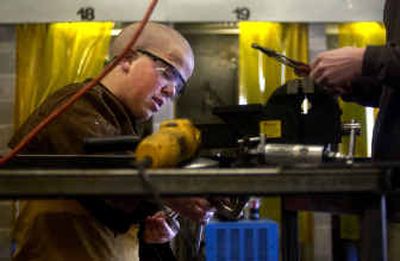Budget proposal cuts funds for voc-ed

Welding isn’t about just metal and fire to David O’Connor.
For the 17-year-old West Valley High School student it’s about taking what he learns every day in the classroom and applying it in the real world.
“It’s hands on – you learn from building, and you learn from your mistakes,” O’Connor said.
Welding is also a job skill he can use after he graduates in 2006. O’Connor wants to join the Navy, but just in case that doesn’t work out, he now has a backup plan, largely because of the welding classes he takes at the Spokane Skills Center.
“Our bottom line is that when students leave here they have an entry-level skill,” said Don Howell, director of the Skills Center. Most can get jobs that pay far above the minimum wage of $7.35 an hour.
“But our ultimate goal is to get them to keep going,” possibly on to college, Howell said.
Come next year, some of the federal money that helps support that goal may be eliminated.
Under the first federal budget proposal from the White House for fiscal year 2005-06, the $1.3 billion currently spent on vocational and technical education in the United States would get the ax. That includes about $23 million for Washington school districts, said Shirley Skidmore, director of communications for the state Office of Superintendent of Public Instruction.
The money would be redirected to President Bush’s new High School Intervention program aimed at raising the achievement of high school students, especially those at risk of not meeting state standards.
“The president was trying to find more money to support his proposed high school testing program … to add more standardized tests in reading and math that will be mandatory,” Skidmore said.
Next year, every student in grades three through eight will take a reading and math standardized test, such as the Washington Assessment of Student Learning, under the federal No Child Left Behind law. The WASL traditionally has been given to students in only grades four, seven and 10.
“He wanted to expand that into high school and needed a way to pay for it,” Skidmore said.
If the president’s proposed budget passes through Congress, the Spokane Skills Center stands to lose $70,000, Howell said.
In addition to having access to the classes at the Skills Center, the Central Valley School District operates its own career and technical education classes at Central Valley and University high schools. They could lose about $60,000 in funds used to help pay for those courses.
Spokane Public Schools would lose about $320,000 in federal funds for its own career and technical education classes, state officials said.
While the loss of those funds wouldn’t force the closure of the Skills Center, or cut the 87 career and technical education classes offered in both Central Valley high schools each year, it would greatly affect the quality.
“What I don’t like about Bush’s budget is that he is just stealing money away from one group of kids and giving it to another,” Howell said. “It’s not adding funding to education; it’s just moving it around.”
The vast majority of federal money disbursed to Washington school districts for career and technical education is made available through the Carl D. Perkins Act. The money is awarded as grants to state education agencies and is allotted according to a formula based on state populations in certain age groups and their per-capita income. That amounts to $23 million in Washington.
“It’s not the primary source of our monies, but it supports our career centers,” said Susan Christenson-Fuhrman, director of career and technical education for Central Valley. “It helps us try to get students who wouldn’t normally look at different career options to look at different career options.”
Students like Charlene Fellows, who attends Barker High School, Central Valley’s alternative high school. Fellows, 18, studies welding at the Skills Center with O’Connor.
“I just wanted a challenge, and I wanted to have a skill when I got out of high school,” Fellows said. “There’s a shortage of welders right now, so it’s nice to have this to put on my resumé.”
While individual states could still choose to use the High School Intervention money for vocational and technical education, advocates like Howell worry that because of the increased emphasis on student achievement, support for the programs eventually would be squeezed out.
“I know there’s a fear out there that this money that has been used for a specific positive purpose would end up being used for something else, like testing.” Skidmore said.
But nationally, vocational and technical education programs are getting support from politicians, Skidmore said.
The U.S. Senate voted March 10 to reauthorize the Perkins bill.
“Any time you see zeros in a budget like that, it gets people’s attention,” Skidmore said. “But the federal updates that I have been getting indicate that there is quite a lot of sentiment among the senators that the Perkins money not go away.”